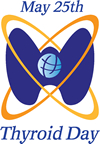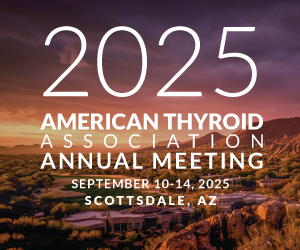 American Thyroid Association collaborates with the European Thyroid Association, the Asia & Oceania Thyroid Association and the Latin American Thyroid Society
American Thyroid Association collaborates with the European Thyroid Association, the Asia & Oceania Thyroid Association and the Latin American Thyroid Society
May 25, 2015
On May 25th the American Thyroid Association (ATA) (www.thyroid.org), in cooperation with international sister societies, the European Thyroid Association (www.eurothyroid.com), the Asia & Oceania Thyroid Association (www.aothyroid.org), and the Latin American Thyroid Society (www.lats.org) , will be making an extraordinary effort to do what it does year-round—focus attention on that small butterfly-shaped gland at the base of the neck that causes some 20 million Americans to experience “dis-ease” of one form or another.
The thyroid gland produces hormones that influence every cell, tissue, and organ in the body. Thyroid hormones regulate the body’s metabolism—the rate at which the body produces energy from nutrients and oxygen—and affects critical body functions, such as energy level and heart rate. Almost everyone knows someone affected by thyroid disease or thyroid cancer. In addition to the 20 million Americans who have some form of thyroid disease, more than 12 percent of the U.S. population will develop a thyroid condition during their lifetime. Perhaps the most stunning statistic is that up to 60 percent of those with thyroid disease are unaware of their condition and that women are five to eight times more likely than men to have thyroid problems.
“It is clearly important that we do more to increase awareness of thyroid diseases and cancers, both in the US and globally,” observes ATA President Dr. Robert Smallridge. “The World Health Organization (WHO) has identified iodine deficiency as the world’s most prevalent, yet easily preventable, cause of brain damage. (Iodine is an essential element in normal thyroid function. Since the body doesn’t make it, iodine must be ingested through the diet.) Consequences of iodine deficiency include physical and mental retardation, cretinism, endemic goiter, hypothyroidism, and poor outcomes in pregnancy. I am proud to note that this year the ATA, the Endocrine Society, and the American Academy of Pediatrics, in cooperation with the Council for Responsible Nutrition (the trade association for the dietary supplement and functional food industry), released dietary guidelines for supplement manufacturers, stating that pregnant and lactating women should receive a daily multivitamin/mineral supplement that contains 150 mcg of iodine. This level of support is critical to assure normal brain development of the fetus and baby. Setting a standard is an important step in addressing this overwhelming, yet preventable, global health issue,” Dr. Smallridge concludes.
In addition to iodine deficiency, the chance of developing other thyroid issues during pregnancy is increased because the thyroid gland produces up to 50 percent more thyroid hormone as compared to when a woman is not pregnant. This increases the likelihood of developing hypothyroidism during pregnancy. The ATA recommends that women at high-risk for thyroid disease should be tested early in their pregnancy.
Hypothyroidism, a condition that occurs when the thyroid gland does not produce enough thyroid hormone, is the most common thyroid disease. Symptoms include fatigue, depression, forgetfulness, irregular menses and weight gain. Treatment of hypothyroidism is usually with a synthetic form of thyroid hormone called “levothyroxine.” With “hyperthyroidism,” the opposite is true—the thyroid gland produces too much thyroid hormone. Symptoms include irritability, nervousness, muscle weakness, unexplained weight loss, sleep disturbances, vision problems and eye irritation. One type of hyperthyroidism, Graves’ disease, is an autoimmune disorder that is partly genetic.
Another autoimmune disease affecting the thyroid is Hashimoto’s thyroiditis. This is the most common cause of hypothyroidism in the US, affecting mostly women. Diagnosis is usually confirmed by symptoms suggesting thyroid underactivity, positive anti-thyroid antibodies, and small goiter (thyroid enlargement) on physical examination. Patients with an elevated blood level of TSH and/or goiter are treated with thyroxine (T4). Thyroid nodules are another common thyroid problem. Patient education brochures on these and many other thyroid conditions are on the ATA website at https://www.thyroid.org/patient-thyroid-information/.
Thyroid cancer is the most rapidly increasing form of cancer in the United States. The National Cancer Institute estimates 62,450 new cases of thyroid cancer will be diagnosed in 2015, nearly a 40 percent increase over 2010 numbers. When thyroid cancer is identified and treated early, the majority of patients can be completely cured. Endocrinologists can sometimes employ minimally invasive procedures to distinguish thyroid cancer from benign thyroid nodules, which are common in the population. Links to management guidelines for thyroid cancer are at http://thyroidguidelines.net/.
It is the ATA’s mission is to support the clinicians and researchers who are at the frontlines of thyroid treatments and research. We also work with the public, patients, and their families to educate and increase awareness of thyroid diseases. It is unfortunate that 60 percent of thyroid disease sufferers go undiagnosed. It is our hope to reach out and help all thyroid patients get the medical services they need. If you have questions or concerns, go to our website at www.thyroid.org and click on “Find a Thyroid Specialist,” or contact us at thyroid@thyroid.org, or call 703-998-8890.
The American Thyroid Association (ATA) is the leading worldwide organization dedicated to the advancement, understanding, prevention, diagnosis and treatment of thyroid disorders and thyroid cancer. ATA is an international individual membership organization for over 1,700 clinicians and researchers from 43 countries around the world, representing a broad diversity of medical disciplines. It also serves the public, patients and their family through education and awareness efforts
Celebrating its 92nd anniversary, ATA delivers its mission through several key endeavors: the publication of highly regarded monthly journals, THYROID, Clinical Thyroidology, VideoEndocrinology and Clinical Thyroidology for the Public; annual scientific meetings; biennial clinical and research symposia; research grant programs for young investigators, support of online professional, public and patient educational programs; and the development of guidelines for clinical management of thyroid disease.
More information about ATA is found at www.thyroid.org.



